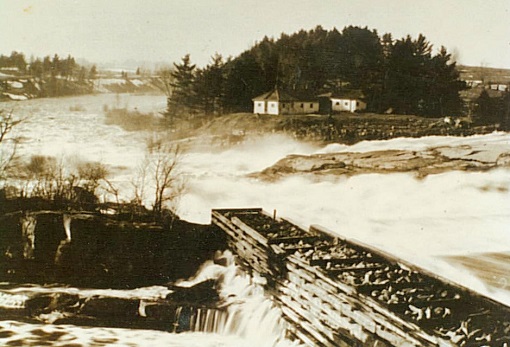History of Hogs Back lockstation
Rideau Canal National Historic Site
Specifications of the lockstation

Hogs Back lockstation stands at the point where the Rideau River and the canal separate in the City of Ottawa. Colonel By decided to dam the river at Hogs Back, raising the level of water high enough to drown rapids and deepen shallow spots in the 6.6 km (4.1 miles) of river between the dam and Black Rapids. The navigation channel that connects Hogs Back to the Ottawa Locks consists of 50% excavated channel and 50% flooded natural features (slackwater system).
The Construction of the lockstation
The contractor for this section was Walter Fenlon. However, he ran into difficulties and was released from his contract in the fall of 1828. Some of Fenlon’s contract was taken over by Philemon Wright & Sons, but Colonel By also brought two Companies (7th & 15th) of Sappers and Miners to the site to work on the project (in late 1829 the 7th company moved to Newboro but the 15th company stayed on this site).The work at Hogs Back, the construction of the dam in particular, turned out to be one of the most challenging endeavours Colonel By would face during the construction of the Rideau Canal. Swift water and intense spring floods made the work difficult. The original plan called for a 13.7 m (45 foot) high stone arch dam with three locks to the west of the dam. Early on Colonel By decided to move two locks towards Ottawa to take advantage of topography (what are now the Hartwells Locks), but due to the intense flooding that he witnessed, he then added a guard lock to his remaining single lift lock at this location.
In February of 1828, an early thaw and a sudden rise of the river washed much of the dam away. Fenlon was working on rebuilding the dam when, in April 1828, spring flood waters washed it away again. He asked to be released from his contract and that was done in the fall of 1828. The Wrights and the Sappers and Miners took over the job. Their work included building a railway to the quarry that was located approximately 300 m (985 feet) from the east side of the river. The stone dam was rebuilt, but in early April of 1829 it started to leak. As Colonel By noted in this description of his visit to inspect the repair work, the dam was eroding underfoot: "I was standing on it with forty men employed in trying to stop the leak when I felt a motion like an earthquake and instantly ordered the men to run, the stones falling from under my feet as I moved off."
A timber crib coffer dam that the Wrights had built had held during these events, so an engineering re-think was done, the idea of a stone arch dam was abandoned and a timber crib (timber cribs filled with large stones) dam built instead. A large amount of stone was also placed on the downstream side of the dam. This is the dam that still exists today.
Problems with spring flooding influenced the construction of the weir. The weir was widened after each flooding event, to try to pass the excess water around the dam. In 1862, flooding washed out a large section of the weir and it was rebuilt. A major reconstruction of the weir was done in 1892-93 after a major flooding event in 1891. The weir has been repaired and modernized several times since.
The spring flooding also convinced Colonel By of the need to add a flood lock, in addition to the lift lock at Hogs Back. A flood lock can be used as a lift lock in times of high flood and it also guards (protects) the lift lock from damage due to ice and debris from spring flooding.
Structures of the lockstation
Former Lockmaster's House: A blockhouse was planned for Hogs Back but was never built. Instead, a defensible lockmaster's house was built in the 1840s. It was a one-storey stone house located on the west bank above the top lock. Photographs of the house at the turn of the century show that it had retained much of its original appearance. It was a one-storey structure with its loopholes filled in with timber. By 1907 the house was reported to be in very poor condition and eventually it was torn down.Current Lockmaster’s House this building dates to the early 1900s. It was originally on the east bank of the locks but moved to the west bank in the 1950s.
- Date modified :